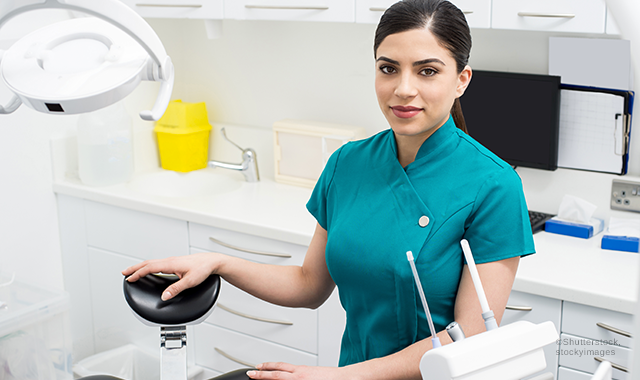Dental hygiene instrumentation then and now
Scientific advances and instrument efficiency are changing the way hygienists provide care.

I graduated from the Fones School of Dental Hygiene during the Jurassic Period of Geologic Time (1970s). These were the days of belt-driven handpieces (that would get stuck in my dark brown hair) and carbon and stainless steel, area-specific curettes. Our hand instruments rolled around the tray like crazy, mostly because the tray was leaning and we kept too many instruments on the tray at one time. When we worked on children in public schools, our professors made us use a porte polisher with an orange wood stick so that we could imagine what it was like to polish teeth back in the early 1900s.
Modern dental hygiene instrumentation choices
Modern dental hygiene instrumentation has eliminated a lot of hand instruments, and dedicated clinicians are no longer expected to work without ultrasonic instrumentation. Scientific advances, the importance of biofilm disruption and subgingival calculus removal at the base of the pocket have changed the way dental hygienists provide nonsurgical periodontal therapy and supportive periodontal maintenance. Instrument efficiency is also more important than ever before because practice management administrators are constantly looking over hygienists’ shoulders, making sure they’re staying on time and meeting practice quotas that meet revenue goals.
I pay close attention to dental hygiene blogs because they show me what’s on the mind of the average dental hygiene clinician. A recent blog question on a popular Facebook group exposed a hot topic with a lot of opinions: whether or not to give up hand instruments and substitute ultrasonic instrumentation instead.
More from the author: Baby Boomers and oral irrigation
Opinions run the gamut of using hand instruments for mandibular anterior teeth ONLY to thinking that ultrasonics don’t provide tactile sensitivity needed for subgingival calculus removal. Let’s review what the literature says on this topic.
Make no mistake: dental hygiene instrumentation has changed for the better and much of it has to do with instrument design and materials, ergonomics, lighting, magnification and endoscopic technology to provide pocket visualization.
Which instrumentation type provides best outcomes?
Can a dental hygiene clinician use only ultrasonic instrumentation and achieve the desired outcome of plaque/biofilm disruption and calculus removal? In a systematic review from 2002, Heinecke and Flemmig concluded that ultrasonic (or sonic) subgingival debridement requires less time than hand instrumentation. In addition, the data didn’t indicate a difference between the two techniques (manual versus ultrasonics) for the treatment of periodontitis in single-rooted teeth, but the evidence wasn’t very strong.1 For multi-rooted teeth, no evidence of efficacy of ultrasonics was found. The authors mentioned that furcation entrances are perhaps better accessed by thinner sonic and ultrasonic tips.1

In 2005, JY Kwan pointed out that hand instruments require sharpening and are limited in their access to root surfaces by their size and shape, especially in deeper periodontal pockets.3 In addition, he mentions the force required for effective calculus removal with hand instruments increases the risk for repetitive stress injuries.2 With powered instrumentation (sonic and ultrasonics), there’s less risk of repetitive stress injury and perhaps more predictable root access due to the availability of thinner ultrasonic insert tips.2
Having authored a couple of articles/columns about periodontal endoscopy, I’ve learned that aggressive, blind scaling without viewing roots frequently damages them. Viewing the root while instrumenting with a micro-ultrasonic tip the size of a periodontal probe makes better sense. When a periodontal endoscope is employed for viewing the tooth and root endoscopically, hand instruments aren’t always needed, and right and left ultrasonic inserts are preferable to straight inserts to better fit concavities and furcations in posterior teeth. Ultrasonic instrumentation with correct technique and instrument adaptation can provide great outcomes without any hand instruments, especially when you employ an endoscope for viewing the periodontal pocket environment.3,4
How important is instrumentation choice based on risk for periodontitis? Biofilm/plaque and calculus deposits account for only about 20 percent of the risk for periodontitis.5 The remaining 80 percent of factors include environmental determinants such as smoking and poorly controlled diabetes and a person’s genetic variation that modifies inflammation and its resolution.5 Even anti-infective therapy alone, like mechanical pocket debridement, fails to effectively manage as many as 25 percent of periodontitis patients, and most people with poor oral hygiene and little to no periodontal care develop only mild/moderate periodontitis. Therefore, the variation of an individual- not the composition of the oral biofilm-determines risk for disease and adverse treatment outcomes.5
Trending article: 8 ways to build rapport with patients
Many dental hygiene clinicians, myself included, prefer a blended technique: ultrasonic and hand instrumentation combined for debridement procedures for improved maneuverability and tactile sensitivity. Some educators prefer to teach students to use hand instruments first, followed by ultrasonics, but it’s easy to damage a root when it can’t be visualized.
Hand curettes require a longer time (more strokes) to achieve similar results to ultrasonic instrumentation, so it’s not always practical to use them in fast-paced settings. Most dental hygiene clinicians have developed the skill set to detect subgingival calculus by tactile sensation, but working blind is a disadvantage to all clinicians.
Ultrasonic devices are a lot more sophisticated than they used to be with better insert/tip designs, and clinicians are enjoying many ergonomic benefits of ultrasonic instrumentation. Instead of hand instruments being the mainstream of dental hygiene instrumentation, ultrasonics have replaced them in most dental practice settings as the preferred instrumentation method of choice.
References
1. Tunkel J, Heinecke A, Flemmig TF. A systematic review of efficacy of machine-driven and manual subgingival debridement in the treatment of chronic periodontitis. J Clin Periodontol 2002; 29(Suppl. 3):S72–S81
2. Kwan JY. Enhanced periodontal debridement with the use of micro ultrasonic periodontal endoscopy. 2005; CDA J. 33(3): 241-248.
3. https://www.rdhmag.com/patient-care/article/16405743/different-strokes-are-used-in-periodontal-instrumentation
4. https://www.rdhmag.com/pathology/periodontitis/article/16408772/let-it-shine-or-do-it-blind
5. Bartold PM, Van Dyke TE. An appraisal of the role of specific bacteria in the initial pathogenesis of periodontal disease. J Clin Periodontol. 2019 46: 6-11.